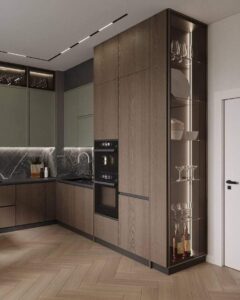Are Stainless Steel Hygienic Kitchens Expensive?

Stainless steel kitchens have long been a staple in commercial settings due to their durability, ease of maintenance, and exceptional hygiene standards. Increasingly, these qualities are making stainless steel a popular choice for residential kitchens as well. However, a common concern among homeowners is whether creating a stainless steel hygienic kitchen is an expensive endeavor. This blog post will explore the costs associated with stainless steel kitchens, compare them to other materials, and delve into the long-term benefits that might justify the initial investment.
Are Stainless Steel Hygienic Kitchens Expensive?
Understanding Stainless Steel in Kitchen
The Benefits of Stainless Steel
Stainless steel is prized in kitchen design for several reasons:
- Hygiene: Stainless steel is non-porous, meaning it does not harbor bacteria and other pathogens. Its smooth surface is easy to clean and sanitize, making it an ideal material for areas where food is prepared.
- Durability: Resistant to rust, corrosion, and heat, stainless steel can withstand the rigors of daily kitchen use. It maintains its appearance and functionality over time, even with minimal maintenance.
- Aesthetic Appeal: The sleek, modern look of stainless steel can enhance the visual appeal of a kitchen, giving it a contemporary and professional appearance.
- Versatility: Stainless steel complements various design styles and can be seamlessly integrated with other materials like wood, glass, or stone.
Components of a Stainless Steel Kitchen
A fully equipped stainless steel kitchen can include countertops, cabinetry, sinks, backsplashes, and appliances. Each component contributes to the overall cost, and understanding the individual pricing can help homeowners make informed decisions.
Cost Factors of Stainless Steel Kitchen
Initial Investment
The upfront cost of a stainless steel kitchen can be higher than that of kitchens made from more conventional materials such as laminate or wood. Here are the primary cost factors:
- Materials: Stainless steel itself is more expensive than many other kitchen materials. High-quality stainless steel, such as 304 grade, is typically used in kitchens due to its superior corrosion resistance and durability.
- Manufacturing: Crafting stainless steel components requires specialized equipment and skilled labor, which adds to the cost. Custom-made pieces, in particular, can be significantly more expensive.
- Installation: Installing stainless steel fixtures and fittings often requires professional expertise. Precise measurements and seamless integration are crucial to achieving a sleek, polished look.
Comparing Costs with Other Materials
To put the costs into perspective, let’s compare stainless steel with other common kitchen materials:
- Laminate: Laminate is one of the most affordable materials for kitchen countertops and cabinets. However, it lacks the durability and longevity of stainless steel, and it is prone to scratching, chipping, and staining.
- Wood: Wood offers a warm, traditional look but requires regular maintenance and can be susceptible to water damage and staining. High-end hardwood options can be quite expensive, sometimes rivaling the cost of stainless steel.
- Granite and Quartz: These materials are popular for countertops due to their durability and aesthetic appeal. While generally less expensive than stainless steel, high-quality granite and quartz can still be costly, especially when considering the installation and maintenance.
Long-Term Financial Considerations
While the initial investment for a stainless steel kitchen can be high, several long-term financial benefits may offset these costs:
- Durability and Longevity: Stainless steel’s durability means that it does not need to be replaced as frequently as other materials. This longevity can result in significant cost savings over time.
- Maintenance Costs: Stainless steel requires minimal maintenance compared to wood or laminate, which may need refinishing, resealing, or frequent repairs.
- Energy Efficiency: Many stainless steel appliances are designed with energy efficiency in mind, potentially reducing utility bills.
- Resale Value: Homes with modern, hygienic stainless steel kitchens can be more attractive to potential buyers, possibly leading to higher resale values.
Enhancing Cost-Effectiveness
Balancing Materials
Homeowners looking to balance cost and quality might consider using stainless steel selectively rather than throughout the entire kitchen. For instance, combining stainless steel countertops with wooden or laminate cabinetry can achieve a high-end look without the associated high cost. Stainless steel sinks and backsplashes can provide the desired hygienic benefits and visual appeal without requiring a full kitchen overhaul.
Choosing the Right Grade
Stainless steel comes in various grades, each with different properties and price points. For most residential kitchens, 304 grade stainless steel is ideal due to its excellent corrosion resistance and durability. However, homeowners can opt for lower grades, such as 430, 202, for areas with less exposure to moisture and food prep. While slightly less durable, these lower-grade options can still provide the desired aesthetic at a reduced cost.
Custom vs. Pre-Fabricated Components
Custom stainless steel components are tailored to fit specific kitchen dimensions and designs, offering a perfect fit and a unique look. However, they come at a premium price. Pre-fabricated stainless steel cabinets, countertops, and sinks are more affordable alternatives that still provide the benefits of stainless steel. While they may not offer the same level of customization, they can significantly reduce the overall cost.
Practical Tips for Installing a Stainless Steel Kitchen
Planning and Budgeting
- Set a Realistic Budget: Before starting any kitchen renovation project, it’s essential to establish a clear budget. Factor in all potential costs, including materials, labor, and contingencies.
- Prioritize Needs: Determine which aspects of the kitchen will benefit most from stainless steel. For example, prioritize high-use areas like countertops and sinks over less critical elements.
- Seek Professional Advice: Consult with kitchen designers or contractors who have experience with stainless steel installations. They can provide valuable insights and help you avoid costly mistakes.
DIY Considerations
For those with a knack for DIY projects, installing certain stainless steel components yourself can save on labor costs. However, it’s crucial to recognize the limitations of DIY work, especially with more complex installations that require precise measurements and professional skills.
Case Studies: Real-Life Examples
Modern Minimalist Kitchen
A homeowner in San Francisco opted for a minimalist kitchen design with stainless steel countertops and a backsplash, combined with white cabinetry. The initial investment was higher than traditional materials, but the kitchen’s sleek, modern look significantly increased the home’s appeal, leading to a faster sale and higher resale value.
Industrial-Inspired Kitchen
In New York City, a couple transformed their kitchen into an industrial-inspired space with stainless steel cabinets, open shelving, and exposed brick walls. The durable, low-maintenance nature of stainless steel suited their busy lifestyle, and the unique design attracted numerous potential buyers when they decided to sell, ultimately resulting in a lucrative sale.
Eco-Friendly Kitchen
A family in Portland, Oregon, incorporated stainless steel into their eco-friendly kitchen renovation. They chose stainless steel appliances and countertops for their durability and recyclability. The energy-efficient stainless steel appliances reduced their utility bills, and the kitchen’s modern, sustainable design appealed to environmentally conscious buyers, enhancing the home’s market value.
Conclusion: Are Stainless Steel Hygienic Kitchen Worth the Cost?
The initial expense of creating a stainless steel hygienic kitchen can be higher than using more conventional materials. However, the long-term benefits, including durability, ease of maintenance, aesthetic appeal, and potential increases in resale value, often justify the investment. By strategically planning and budgeting, homeowners can incorporate stainless steel elements that provide the desired benefits without exceeding their financial limits. Ultimately, a stainless steel kitchen offers a combination of hygiene, functionality, and style that can elevate any home, making it a worthwhile investment for those looking to enhance their living space and boost their property’s marketability.
Ready to explore a Basic Range of Wood, an Affordable range of galvanized steel and Premium stainless steel kitchen cabinets in Bangalore, kitchen interior & wardrobe solutions for your space? with different combination shutters complete home interiors in steel with Stainless Steel PVD Furniture Contact Karvi Interio today for personalized consultations and expert design services. Visit our website to discover the efficiency and durability of stainless steel wardrobes tailored to your needs. Construction for interior products Gauge, visit our YouTube channel for information videos, Before visiting the showroom some of the steps to follow, Looking for Collaboration with US, About warranty & guarantee, Transform your storage spaces with Karvi Interio’s expertise!

